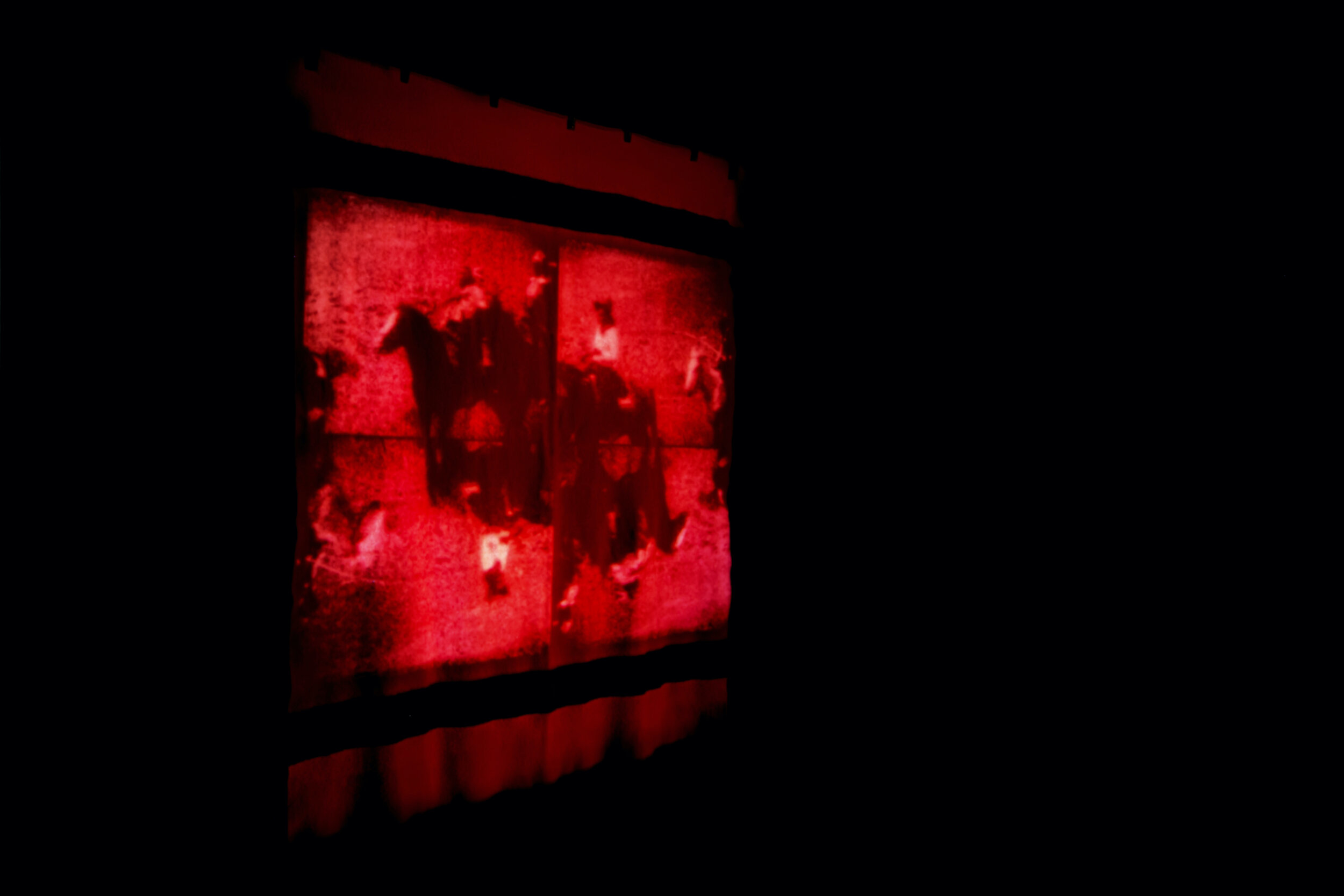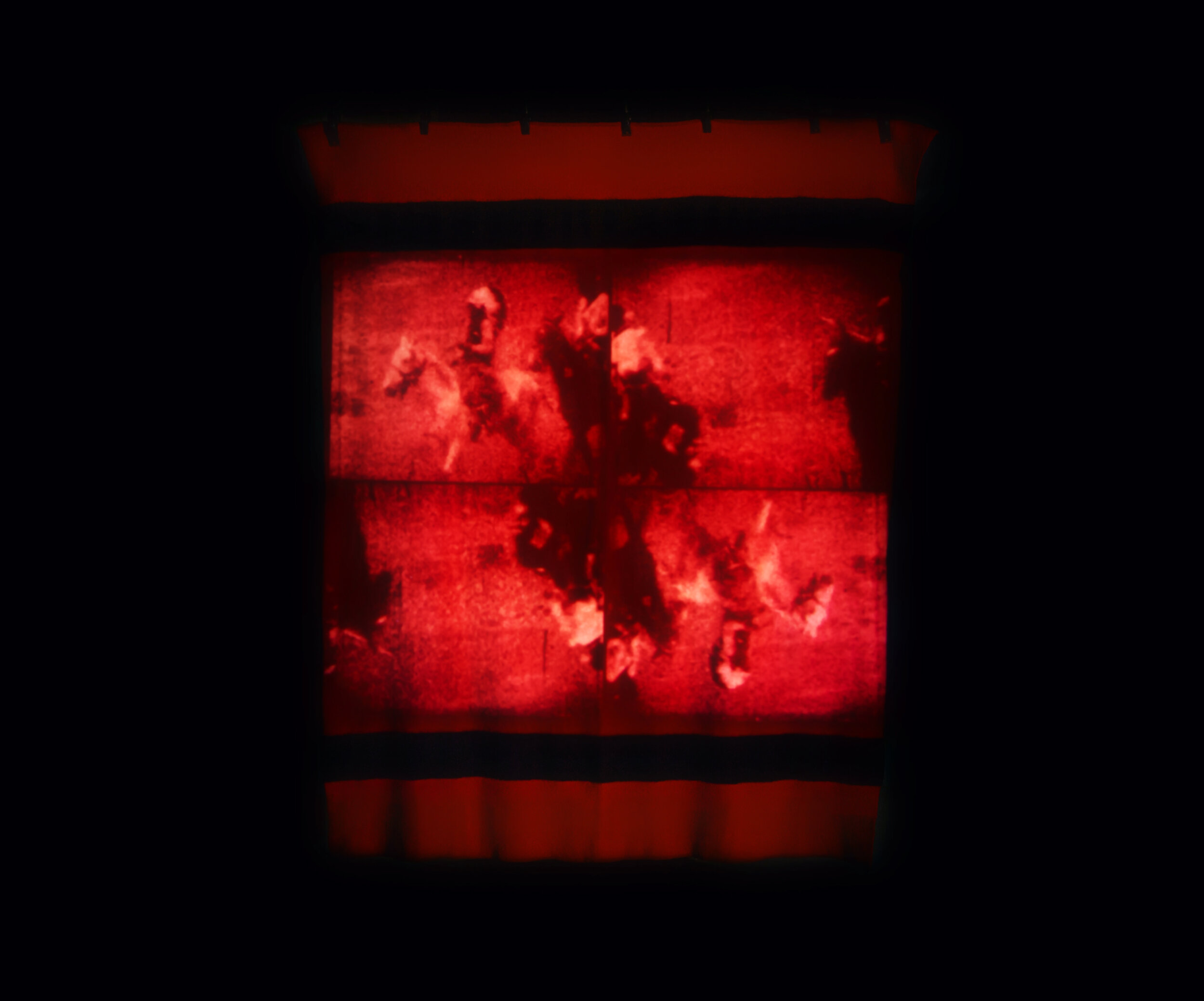Alan Michelson
Alan Michelson
Pehin Hanska ktepi (They killed Long Hair), 2021, single channel video installation: wool blanket and video projection, 84 X 68 in. Duration: 00:01:05 (looped).
Courtesy the artist.
Alan Michelson, a Mohawk member of the Six Nations of the Grand River, is known for his multimedia installations that deconstruct American settler colonial history through the activation and reinterpretation of archives from an Indigenous perspective. Pehin Hanska ktepi (They killed Long Hair) consists of archival film footage projected onto an antique wool trade blanket. The footage depicts Indigenous veterans of the Battle of the Greasy Grass (1876), known colloquially as Custer’s Last Stand, who on occasion of the battle’s fiftieth anniversary in 1926 returned to the site near Little Bighorn River to commemorate the Lakota, Dakota, Cheyenne, and Arapaho victory with a mounted parade. Michelson has looped the remarkable film footage into a continuous procession of riding warriors that references the Winter Count, the pictographic calendar form used by Plains tribes to document memorable events, typically painted onto buffalo hides (and later fabrics like muslin) in spirals or horizontal rows. The work is titled after the Lakota name for 1876 in the Winter Count, and the blanket replaces the hide as a substrate for the figures of the mounted veterans. The looped, gridded format evokes cyclical conceptions of time and the enduring power of Indigenous survivance, or active presence and resistance, as it manifests across generations.
DESCRIPTION
A view of a darkened space at the back of the gallery in which a red blanket hangs from the ceiling. The blanket is eighty four inches long and sixty eight inches wide and hangs vertically, filling the center of the image. It hangs from the ceiling at a forty-five degree angle to the gallery walls which are difficult to see in the dark background. Two thick black stripes run across the blanket about one sixth of its length from the top and bottom edges, respectively. The black stripes frame the top and bottom of a nearly square field in the center of the blanket. This square field is filled by a black, red, and white still image of a projection of Native American men on horseback in a grassy and hilly landscape. The projection is divided into four quadrants, the bottom two of which are mirrored images of the top that have been flipped across the vertical axis. The men on horseback follow one another in a mounted parade. The front rider is on a white horse and wears a white feathered headdress, and the man following him is wearing a white shirt and riding a dark horse. The mirroring effect is kaleidoscopic, and the frames of the projection appear to flow into the next.
ARTIST BIO
Alan Michelson is an internationally recognized New York-based artist, curator, writer, lecturer and Mohawk member of the Six Nations of the Grand River. For over thirty years, he has been a leading practitioner of a socially engaged, critically aware, site-specific art grounded in local context and informed by the retrieval of repressed histories. Recent exhibitions include Wolf Nation, Whitney Museum of American Art, Volume 0, Zuecca Projects, Venice, and Citizenship: A Practice of Society, MCA Denver. His work is in the permanent collections of the Whitney Museum of American Art, the National Gallery of Canada, the Smithsonian National Museum of the American Indian, and the Art Gallery of Ontario. His essays have recently appeared in Frieze and October. Public art is also part of his diverse practice, and Mantle, his large-scale monument honoring Virginia’s Indian nations was dedicated at the capitol in Richmond in 2018. Michelson is co-founder and co-curator, with the Vera List Center for Art and Politics at the New School, of the groundbreaking Indigenous New York series.
ABOUT THIS PAGE
This webpage provides both images and description to render a virtual experience of each artist’s work. Below is an image gallery that includes installation shots, video, and details of Alan Michelson’s installation. In-depth written descriptions that provide visual, auditory, contextual, and other sensory information are available below the image gallery.
Exhibition Photography © EFA Project Space/Yann Chashanovski


